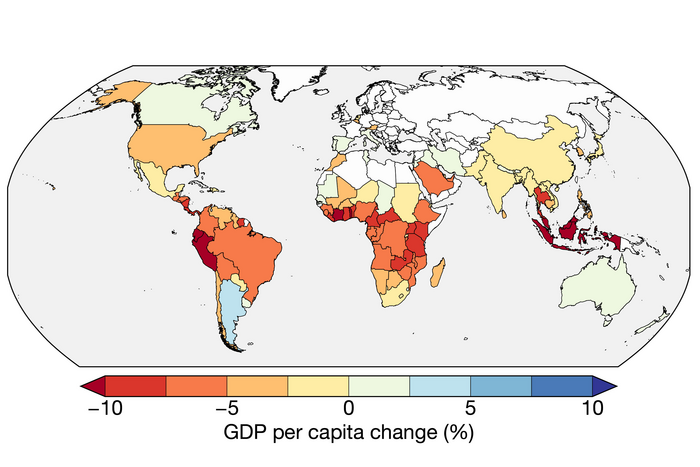
In the years it strikes, the band of warm ocean water spanning from South America to Asia known as El Niño triggers far-reaching changes in weather that result in devastating floods, crop-killing droughts, plummeting fish populations and an uptick in tropical diseases.
With El Niño projected to return this year, Dartmouth College researchers report in Science that the financial toll of the recurring climate pattern can persist for several years after the event itself — and cost trillions in lost income worldwide. The study is among the first to evaluate the long-term costs of El Niño, and it projects losses that far exceed those estimated by previous research.
El Niño is the warm phase of the El Niño-Southern Oscillation, the natural cycle of warm and cold temperatures in the tropical Pacific Ocean that includes La Niña, El Niño’s cooler counterpart. El Niño alters weather patterns worldwide and, in the United States, typically results in wetter, warmer winters for the West Coast and a milder hurricane season on the Atlantic seaboard.
The researchers (Justin Mankin, an assistant professor of geography, and doctoral candidate Christopher Callahan) spent two year examining global economic activity in the decades following the 1982–83 and 1997–98 El Niño events and found a “persistent signature” of slowed economic growth more than five years later. The global economy bled $4.1 trillion and $5.7 trillion, respectively, in the half-decade after each of these events, most of it borne by the world’s poorest nations in the tropics.

By 2003, lower-income tropical nations had experienced the greatest losses in gross domestic product due to the 1997-98 El Niño. (Image by Christopher Callahan)
The researchers project that global economic losses for the 21st century will amount to $84 trillion as climate change potentially amplifies the frequency and strength of El Niño — even if current pledges by world leaders to reduce carbon emissions come to fruition. The researchers estimate that the El Niño predicted for 2023 alone could hold the global economy back by as much as $3 trillion by 2029.
Lead author Christopher Callahan, a U.S. National Science Foundation Graduate Research Fellow, said the study addresses an ongoing debate about how quickly societies rebound from major climate events such as El Niño.
“We can say with certainty that societies and economies absolutely do not just take a hit and recover,” said Callahan, adding that the data suggest that a downturn after El Niño could last as long as 14 years.
Courtesy of U.S. National Science Foundation & Dartmouth University.
Related story: Hottest Day Ever — 3 Days In A Row
I don’t like paywalls. You don’t like paywalls. Who likes paywalls? Here at CleanTechnica, we implemented a limited paywall for a while, but it always felt wrong — and it was always tough to decide what we should put behind there. In theory, your most exclusive and best content goes behind a paywall. But then fewer people read it! We just don’t like paywalls, and so we’ve decided to ditch ours. Unfortunately, the media business is still a tough, cut-throat business with tiny margins. It’s a never-ending Olympic challenge to stay above water or even perhaps — gasp — grow. So …




